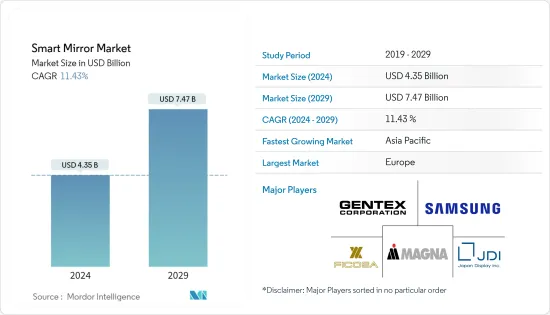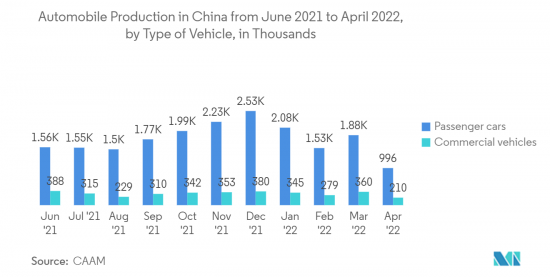PUBLISHER: Mordor Intelligence | PRODUCT CODE: 1406078

PUBLISHER: Mordor Intelligence | PRODUCT CODE: 1406078
Smart Mirror - Market Share Analysis, Industry Trends & Statistics, Growth Forecasts 2024 - 2029

The Smart Mirror Market size is estimated at USD 4.35 billion in 2024, and is expected to reach USD 7.47 billion by 2029, growing at a CAGR of 11.43% during the forecast period (2024-2029).
Key Highlights
- Due to its unique qualities, smart mirror finds applications in a wide range of end-user sectors. However, only applications found in the automotive and retail industries stand to be an outstanding source of demand for smart mirrors in the present market environment.
- Smart mirrors provide value-added services such as virtual reality, entertainment, and personalized information, which improve user happiness and engagement in the aforementioned areas. Furthermore, as customers become more attentive to their grooming regimens, skincare, and well-being, these goods are seeing substantial development.
- Moreover, smart mirrors offer virtual try-ons of makeup, accessories, and apparel, providing customers with an immersive shopping experience, which is why it is gaining favor in the retail arena. Furthermore, smart mirrors may show product information, promotions, and tailored advertisements, creating an interactive and engaging experience for consumers, leading to higher acceptance and market growth.
- Furthermore, the growing attention and demand for sustainable and energy-efficient smart mirrors that consume less energy or electricity are likely to provide significant market potential prospects in the future years.
- Various players are focusing on new product development to meet the growing demand and gain a competitive edge in the market. For instance, in February 2022, MySize, Inc. announced the introduction of its FirstLook Smart Mirror to provide shoppers in physical stores with an improved online shopping experience and contactless checkout.
- Smart mirrors, on the other hand, are frequently connected with sensors, cameras, and connection functions, raising worries about user security and privacy. Smart mirrors gather and analyze personal data, which, if not managed carefully and securely, might result in unauthorized access or privacy violations. Such concerns make it critical for customers to develop confidence in such goods and limit consumer adoption of smart mirrors.
- It is predicted that in the post-pandemic COVID-19 world, lifestyles are expected to alter dramatically. The leading companies of the smart mirror market concentrated and focused on designing sustainable business strategies to mitigate the COVID-19 crisis to a decent level. Fuse Project, a startup, recently created an amazing AI-powered smart mirror that showed exercises and fitness programs. These 6-foot smart mirrors (forme) include a camera, microphone, and speakers. The station also has pulleys and high-quality cast aluminum arms, allowing the user to attend boxing, guided meditation, and yoga courses, which might increase the growth of the market.
Smart Mirror Market Trends
Automotive Sector is Expected to Witness Significant Growth
- Mirrors are crucial for ensuring the safety of automobiles. Nevertheless, traditional mirrors come with certain drawbacks, such as excessive brightness, a restricted range of vision, damage susceptibility, and aerodynamic drag. Smart mirrors improve or replace the traditional rear and side-view mirrors, thereby increasing safety, providing more comfort, and increasing convenience.
- Furthermore, the driver may alternate between the monitor and conventional views. A high-end camera is positioned on the rear sides of the vehicles to provide an uninterrupted view of the rear flanks, enabling the driver to assess blind spots and other traffic circumstances. As a result, the extra advantages of smart mirrors over regular mirrors in the automotive industry are propelling the worldwide smart mirror market forward.
- The smart mirror helps drivers spot pedestrians, cyclists, and other automobiles that may be located behind them, even in the presence of windowless rear doors or partitions in the way. Full Display Interior Mirror presents a live feed from a camera on the rear of the vehicle and features automatic brightness control for optimum visibility in daylight and at night. This assists drivers in being more aware of their surroundings, such as when approaching roundabouts, switching lanes, or checking before turning or merging into side streets.
- The assembly of smart mirrors, such as sensors, displays, cameras, connectivity, and audio systems, have a higher cost than products offered in the software or services divisions, and as the rise of these hardware components continues, so will the expansion of smart mirrors.
- The need for smart mirrors in the car industry will rise as energy consumption standards tighten. Its variable light transmission property, as well as altering voltage, heat, and light, has made it more profitable in the automobile industry. This function also aids in meeting government energy-saving regulations by lowering heating, lighting, and air-conditioning expenditures.
- Moreover, several players such as Harman, Ford, and Nissan offer a smart mirror to enhance the visual perception of drivers and occupants by delivering important details like the distance to other vehicles or speed.

North America is Expected to Hold Largest Market Share
- North America has the biggest market share. The region's expansion of smart mirrors may be ascribed to the region's rising adoption of smart technology, increased customer desire for personalized experiences, and the convenience they give.
- Smart mirrors have developed as a popular choice for customers due to their unique blend of utility, convenience, and aesthetic appeal. Their capacity to show real-time information, effortlessly interact with virtual assistants, and provide personalized features has considerably contributed to their appeal among North American families.
- Furthermore, due to the rising usage of e-commerce, market participants are expected to benefit from easier online distribution of smart mirrors. In the future years, market development will be aided by innovation and the adoption of sophisticated technology-enabled smart mirrors across the distribution chain.
- The widespread use of smart mirrors in retail, consumer, and auto segments is the primary driver of market development in these areas. One of the key factors influencing the smart mirror market in this region is the increased emphasis on providing delightful and smooth shopping experiences to consumers in the retail sector in order to boost customer retention.
- For instance, in May 2022, H&M Group announced the employment of smart mirrors across its Cos stores in the US to provide personalized styling recommendations and virtual try-ons. Through this launch, the company aims to build more relevant and meaningful relationships with clients.
- The rising availability of various voice assistants, the incorporation of AI in many smart home products, and the fast-expanding demand for IoT-enabled smart appliances are the factors predicted to fuel the expansion of the region's smart mirror market.
Smart Mirror Industry Overview
The market is moderately fragmented, attributable to the existence of significant firms that have a global presence. Because of the changing variables that are driving this growth, it is vital for enterprises in this field to stay on top of the market's pulse.
In May 2023, Gentex Corp. announced a strategic agreement with ADASKY as the lead investor in a Series B round of financing. Additionally, they have established a commercial, engineering, and manufacturing collaboration agreement to facilitate the introduction of ADASKY's proprietary technology to the market. ADASKY's LWIR (Long Wave Infrared) sensors have gained recognition in the industry for their exceptional performance thanks to their superior size-to-performance ratio, solid-state technology, high reliability, and "shutterless" constant operation design. These advanced sensing systems address the need for passenger and pedestrian safety, filling the existing gaps in technology by enabling ADAS and vision-based systems to operate reliably in low light and all weather conditions.
In January 2023, Magna's advanced ClearView vision technology made its manufacturing debut on the Ram 2500 and 3500 heavy-duty trucks. This innovative system, combining camera and mirror technology, has the potential to reduce blind spot incidents and enhance safety by improving visibility around the vehicle. The ClearView system includes an internal rear-view video mirror, outside mirrors with integrated cameras, and a high-mounted stop lamp camera in the center. An optional extra trailer camera is available to provide an uninterrupted view while towing. All camera data is processed by Magna's software in a central electronic control unit.
Additional Benefits:
- The market estimate (ME) sheet in Excel format
- 3 months of analyst support
TABLE OF CONTENTS
1 INTRODUCTION
- 1.1 Study Assumptions and Market Definition
- 1.2 Scope of the Study
2 RESEARCH METHODOLOGY
3 EXECUTIVE SUMMARY
4 MARKET INSIGHTS
- 4.1 Market Overview
- 4.2 Industry Value Chain Analysis
- 4.3 Industry Attractiveness - Porter's Five Forces Analysis
- 4.3.1 Bargaining Power of Suppliers
- 4.3.2 Bargaining Power of Consumers
- 4.3.3 Threat of New Entrants
- 4.3.4 Threat of Substitutes
- 4.3.5 Intensity of Competitive Rivalry
5 MARKET DYNAMICS
- 5.1 Market Drivers
- 5.1.1 Growing adoption of smart mirrors in the automotive sector
- 5.1.2 Growing investment in R&D to improve product portfolio
- 5.2 Market Restraints
- 5.2.1 Hight Cost and Lack of Awareness
- 5.3 Assessment of Impact of COVID-19 on the Industry
6 MARKET SEGMENTATION
- 6.1 By Component
- 6.1.1 Hardware
- 6.1.2 Software
- 6.1.3 Services
- 6.2 By End-User Application
- 6.2.1 Healthcare
- 6.2.2 Automotive
- 6.2.3 Retail and Marketing
- 6.2.4 Residential
- 6.3 By Geography
- 6.3.1 North America
- 6.3.2 Latin America
- 6.3.3 Europe
- 6.3.4 Asia-Pacific
- 6.3.5 Middle East and Africa
7 COMPETITIVE LANDSCAPE
- 7.1 Company Profiles
- 7.1.1 Gentex Corp.
- 7.1.2 Ficosa (Panasonic)
- 7.1.3 Magna International Inc.
- 7.1.4 Samsung Electronics Co., Ltd.
- 7.1.5 Japan Display Inc.
- 7.1.6 Murakami Corporation
- 7.1.7 Dension Ltd.
- 7.1.8 Electric Mirror Inc.
- 7.1.9 Perseus Mirror
8 INVESTMENT ANALYSIS
9 MARKET OPPORTUNITIES AND FUTURE TRENDS




